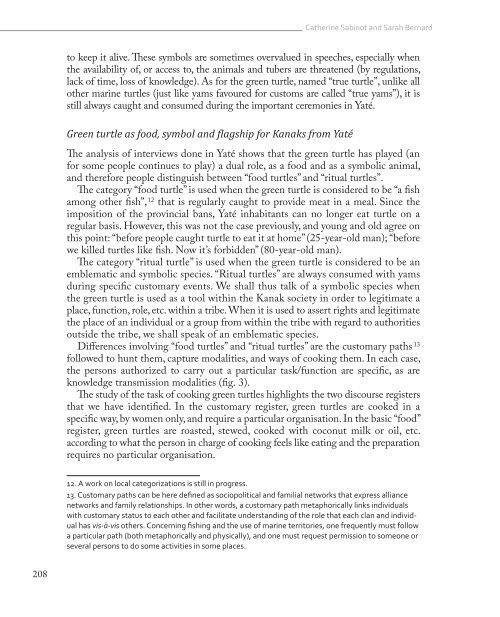Fisheries in the Pacific
Fisheries_in_the_Pacific
Fisheries_in_the_Pacific
You also want an ePaper? Increase the reach of your titles
YUMPU automatically turns print PDFs into web optimized ePapers that Google loves.
Ca<strong>the</strong>r<strong>in</strong>e Sab<strong>in</strong>ot and Sarah Bernard<br />
to keep it alive. These symbols are sometimes overvalued <strong>in</strong> speeches, especially when<br />
<strong>the</strong> availability of, or access to, <strong>the</strong> animals and tubers are threatened (by regulations,<br />
lack of time, loss of knowledge). As for <strong>the</strong> green turtle, named “true turtle”, unlike all<br />
o<strong>the</strong>r mar<strong>in</strong>e turtles (just like yams favoured for customs are called “true yams”), it is<br />
still always caught and consumed dur<strong>in</strong>g <strong>the</strong> important ceremonies <strong>in</strong> Yaté.<br />
Green turtle as food, symbol and flagship for Kanaks from Yaté<br />
The analysis of <strong>in</strong>terviews done <strong>in</strong> Yaté shows that <strong>the</strong> green turtle has played (an<br />
for some people cont<strong>in</strong>ues to play) a dual role, as a food and as a symbolic animal,<br />
and <strong>the</strong>refore people dist<strong>in</strong>guish between “food turtles” and “ritual turtles”.<br />
The category “food turtle” is used when <strong>the</strong> green turtle is considered to be “a fish<br />
among o<strong>the</strong>r fish”, 12 that is regularly caught to provide meat <strong>in</strong> a meal. S<strong>in</strong>ce <strong>the</strong><br />
imposition of <strong>the</strong> prov<strong>in</strong>cial bans, Yaté <strong>in</strong>habitants can no longer eat turtle on a<br />
regular basis. However, this was not <strong>the</strong> case previously, and young and old agree on<br />
this po<strong>in</strong>t: “before people caught turtle to eat it at home” (25-year-old man); “before<br />
we killed turtles like fish. Now it’s forbidden” (80-year-old man).<br />
The category “ritual turtle” is used when <strong>the</strong> green turtle is considered to be an<br />
emblematic and symbolic species. “Ritual turtles” are always consumed with yams<br />
dur<strong>in</strong>g specific customary events. We shall thus talk of a symbolic species when<br />
<strong>the</strong> green turtle is used as a tool with<strong>in</strong> <strong>the</strong> Kanak society <strong>in</strong> order to legitimate a<br />
place, function, role, etc. with<strong>in</strong> a tribe. When it is used to assert rights and legitimate<br />
<strong>the</strong> place of an <strong>in</strong>dividual or a group from with<strong>in</strong> <strong>the</strong> tribe with regard to authorities<br />
outside <strong>the</strong> tribe, we shall speak of an emblematic species.<br />
Differences <strong>in</strong>volv<strong>in</strong>g “food turtles” and “ritual turtles” are <strong>the</strong> customary paths 13<br />
followed to hunt <strong>the</strong>m, capture modalities, and ways of cook<strong>in</strong>g <strong>the</strong>m. In each case,<br />
<strong>the</strong> persons authorized to carry out a particular task/function are specific, as are<br />
knowledge transmission modalities (fig. 3).<br />
The study of <strong>the</strong> task of cook<strong>in</strong>g green turtles highlights <strong>the</strong> two discourse registers<br />
that we have identified. In <strong>the</strong> customary register, green turtles are cooked <strong>in</strong> a<br />
specific way, by women only, and require a particular organisation. In <strong>the</strong> basic “food”<br />
register, green turtles are roasted, stewed, cooked with coconut milk or oil, etc.<br />
accord<strong>in</strong>g to what <strong>the</strong> person <strong>in</strong> charge of cook<strong>in</strong>g feels like eat<strong>in</strong>g and <strong>the</strong> preparation<br />
requires no particular organisation.<br />
12. A work on local categorizations is still <strong>in</strong> progress.<br />
13. Customary paths can be here def<strong>in</strong>ed as sociopolitical and familial networks that express alliance<br />
networks and family relationships. In o<strong>the</strong>r words, a customary path metaphorically l<strong>in</strong>ks <strong>in</strong>dividuals<br />
with customary status to each o<strong>the</strong>r and facilitate understand<strong>in</strong>g of <strong>the</strong> role that each clan and <strong>in</strong>dividual<br />
has vis-à-vis o<strong>the</strong>rs. Concern<strong>in</strong>g fish<strong>in</strong>g and <strong>the</strong> use of mar<strong>in</strong>e territories, one frequently must follow<br />
a particular path (both metaphorically and physically), and one must request permission to someone or<br />
several persons to do some activities <strong>in</strong> some places.<br />
208


